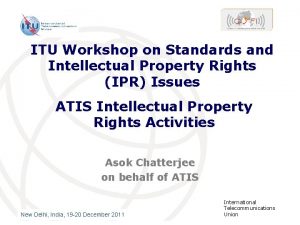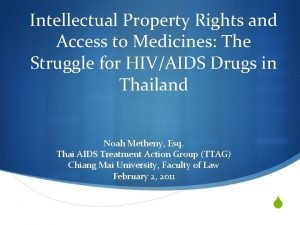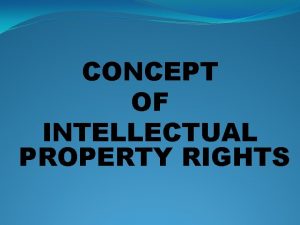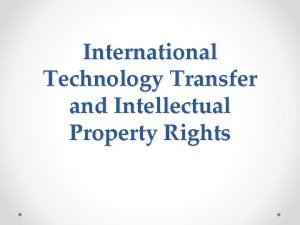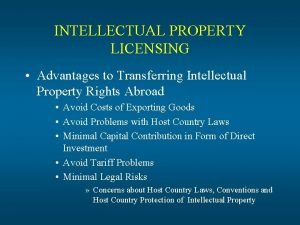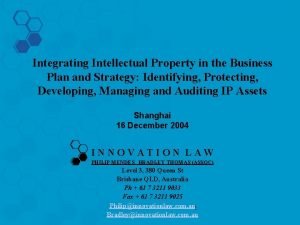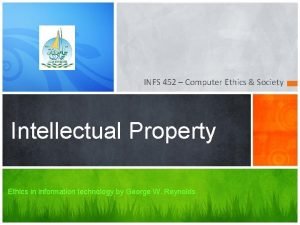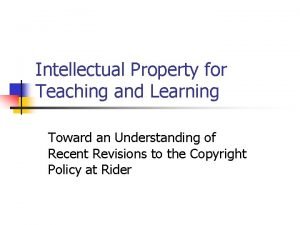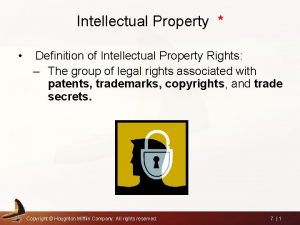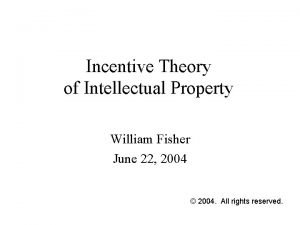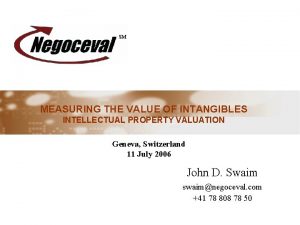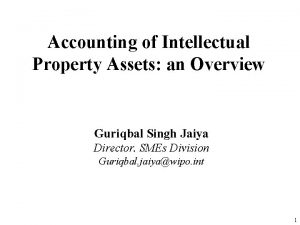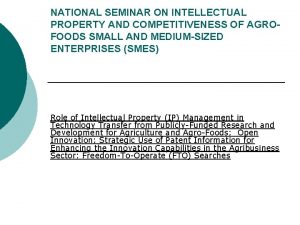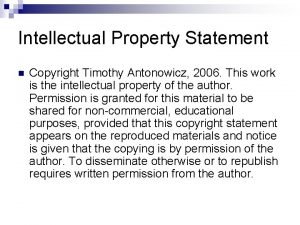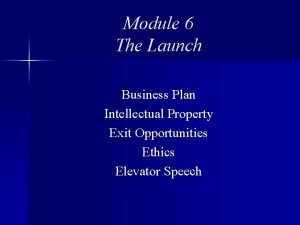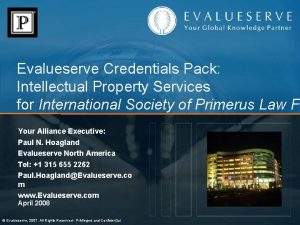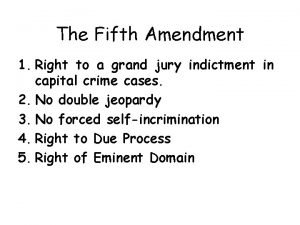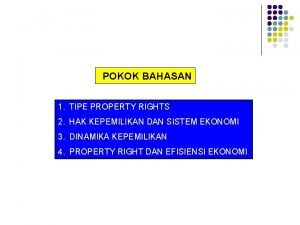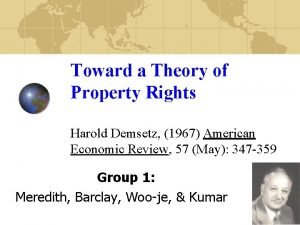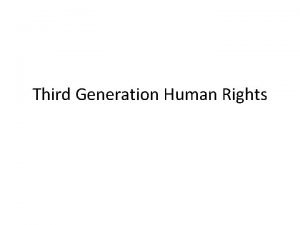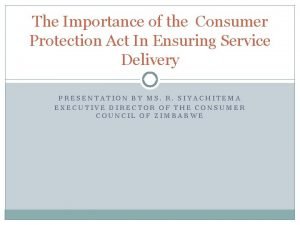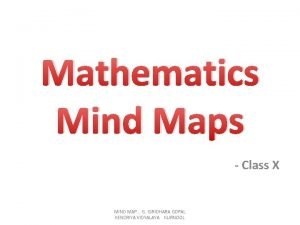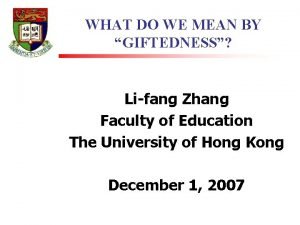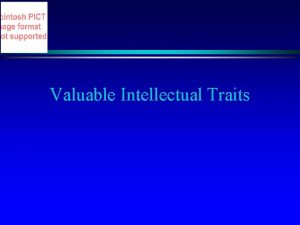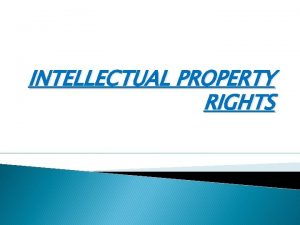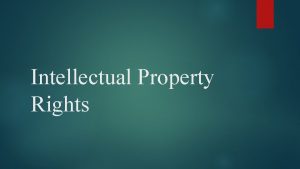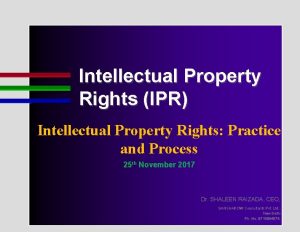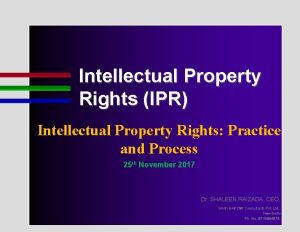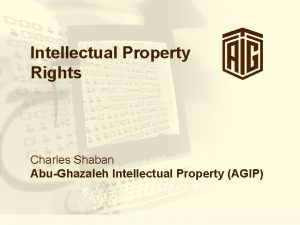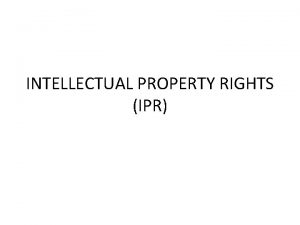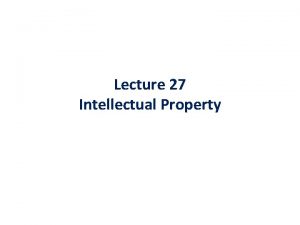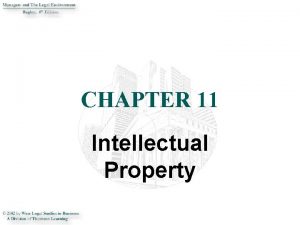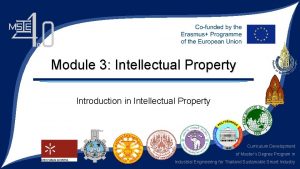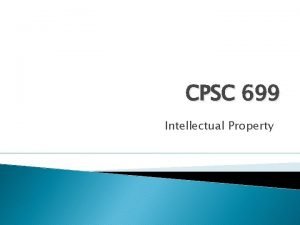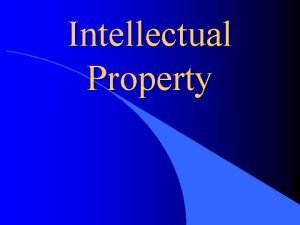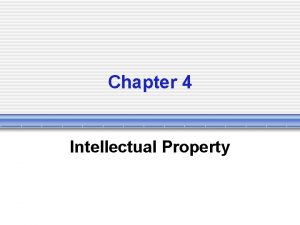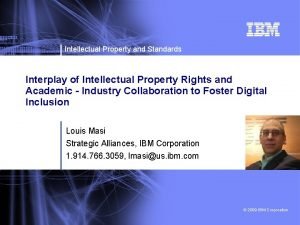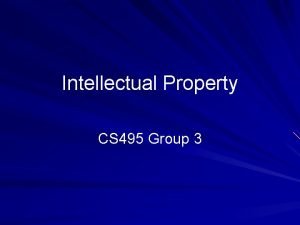Introduction to Intellectual Property Rights CONCEPT OF PROPERTY
















































- Slides: 48

Introduction to Intellectual Property Rights

CONCEPT OF PROPERTY ØNatural object becomes a resource when it satisfies a human want ØA resource possessed and owned becomes a property ØA bundle of legal rights linked to ownership and possession of an item Ø (Tangible: related to physical objects)

INTELLECTUAL PROPERTY It is the PROPERTY CREATED BY APPLICATION OF HUMAN MIND ØIntangible (non-physical) in naturederives value from ideas ØThere is no uniform definition of IP Ø In knowledge age, IP is a key to techno-economic growth

IP UBIQUITOUS IN LIFE ØArticles of food, furniture, clothing, textiles, cosmetics, pharmaceuticals, entertainment gadgets, machinery, books, etc. are all IP protected. ØDomain of IP is ever expanding with advent of Technology and Globalization : GI, IC topography are new additions, TK/Biodiversity are likely additions

RATIONALE BEHIND IP ¬ The creative activity culminating in IP is necessary for socio-economic progress ¬ Material incentives and rewards encourage greater creative activity ¬ IP rights grant monopoly to ensure rewards ¬ The interests of owner and society are balanced by limiting periods of monopoly with obligation to disclose and remedies against abuse of rights ¬ Disclosure brings knowledge in public domain

NATURE OF IPRs ¬ Essentially negative rights to stop others from copying or counterfeiting – In patents, being first with an invention pre-empts any right of another making same invention independently. – In copyrights, the right is diluted as right is over the form of expression and not over idea. ¬ IPRs being statutory rights are legally enforceable. ¬ They are territorial in nature.

7 MAIN IP INSTRUMENTS ØPatents ØTrademarks, Trade Names & Services Marks ØGeographical Indications ØIndustrial Designs ØLayout-designs of Integrated Circuits ØTrade Secrets ØCopyrights And Related Rights First six are Industrial Property Rights

Patents

PATENT: WHAT IS IT? It is a limited right granted by the state to an inventor in respect of an invention to exclude any other person from practicing the invention i. e. manufacturing, using or selling the patented product or from using the patented process, without due permission.

WHAT CAN BE PATENTED? Inventions in all fields of technology, whether products or processes, if they meet the criteria of ¬ Being patentable subject matter; ¬ Novelty; ¬ Non-obviousness (inventive step); ¬ Industrial application (utility).

Conditions of Patentability ¬Novelty: Invention not known to public prior to claim by inventor ¬Inventive Step: Invention would not be obvious to a person with ordinary skill in the art ¬Industrial Application: Invention can be made or used in any useful, practical activity as distinct from purely intellectual or aesthetic one

SOME EXCLUSIONS FROM PATENTABILITY ¬ Naturally occurring substances/elements; ¬ Diagnostic, therapeutic and surgical methods of treatment of humans or animals; ¬ Plants and animals other than μ-organisms; ¬ Essentially biological processes for production of plants or animals; ¬ Inventions whose use is contrary to public order or morality. ¬ Ideas, methods for business, playing games, performing mental acts.

PATENT: SPECIAL REQUIREMENT Disclosure of invention ØSufficiently clear and complete so that a person skilled in the art can carry out the invention. ØA country may require the best mode for carrying out the invention to be disclosed.

TRADEMARKS 4711 (Cologne)

TRADEMARK, SERVICE MARK, and TRADE NAME ØDistinctive symbols, signs, logos that help consumer to distinguish between competing goods or services. ØA trade name is the name of an enterprise which individualizes the enterprise in consumer’s mind. Legally not linked to quality. In fact, linked in consumer’s mind to quality expectation.

TYPES OF MARKS ¬Well Known Trade Mark ¬Collective Mark: Proprietor is an association of persons, which is legally not a partnership ¬Certification Mark: Does not indicate origin of goods but certifies the goods as conforming to certain characteristics (quality, ingredients, geographical origin etc. ) e. g. ISI, AGMARK, Hallmark etc.

Forms of TM ¬Visual: Words, letters, numerals, devices including drawings and symbols or 2 -D representations of object or a combination of two or more of these, colour combinations or colour per se, 3 -D sign as shape of goods or packaging. ¬Audio: Sounds, Musical Notes ¬Olfactory: Smells

CRITERIA OF TM PROTECTABILITY ¬ Distinctive (basic function): - inherent (e. g. RIN), or - acquired by usage (e. g. TATA) ¬ Non-deceptive ( to avoid misleading) ¬ Not contrary to public order, morality Special Requirements v A mark is registered for specified classes of goods or services.

What is protected and what’s not? ¬ Right to use TM in relation to goods/ services as registered are protected (If TM consists of several parts, protection is for TM as a whole) ¬State Emblems, Official Hallmarks, Emblems of Intergovernmental Organizations cannot be used as TM.

GEOGRAPHICAL INDICATIONS Paithani weaving

What is GI? ¬ Many goods possess their peculiar properties due to their geographical origin. ¬ GI is the best method to indicate the geographical origin of goods and services. ¬ Many agricultural products (tea, rice); dairy products (cheese), wines and spirits (Champagne) owe their special quality and reputation to their geographical place of growth or processing.

Protection of GI ¬ GI is not owned by a single owner ¬ Any producer in the region can use the GI on the product provided it is prepared by the norms set out for the use of that GI. ¬ GI is registered in the national register and is similar to the certification mark identifying the origin of the good. ¬ Govt. can register GI in the international register maintained by WIPO for world wide protection. ¬ It is an offence to use false GI on goods.

Industrial Designs

What are Industrial Designs? The ornamental or aesthetic aspect of an article that enhances visual appeal and differentiates product. e. g. 3 -D features of shape or surface as of a perfume bottle, 2 -D patterns of lines, shapes and colours as on a bed sheet.

Criteria for Protection as ID v. New and Original v. Capable of mass production or application on an article of utility v. Not contrary to public order or morality v. The shape should not be determined merely by the functionality of the good.

Comparison of ID against TM ID TM ¬Has to be integral ¬Is applied on the part of product but need not be embodied in it. ¬ Should be ¬Should be original distinctive and new but need not be distinctive

ID, Copyright, Patent ØIf the article is not mass produced or the design can not be applied on a useful article, the design would be an aesthetic work, protectable under copyright. ØSome engineering designs may be sufficiently innovative, protectable as a patent.

ID Protection Protects commercial exploitation of the design idea through products/articles that embody it or reproduce it and not the articles themselves.

Integrated Circuit Layout Designs

What is Layout Design? Layout of transistors and other circuit elements, including lead wires connecting such elements and expressed in any manner in a semiconductor integrated circuit (IC).

Why to protect? ¬IC Layouts are creations of human mind; ¬There is lot of investment of time and money in the creation but copying is very cheap; ¬Fertile area with new circuit designs made every day to cater for miniaturization and novel applications.

Why special protection? ¬There may not be novelty so cannot be patented; ¬Copyright protection does not return the investments since commercial life of a design is limited.

Protection is against… ¬Act of reproducing a layout design fully or in parts; ¬Importing, selling or distributing commercially a protected layout design or IC incorporating it. But identical design created independently by third party is not prohibited.

Trade Secret The best kept secret till date

Trade Secrets ¬Some inventions, data, information cannot be protected by any of the available means of IPRs. Such information is held confidential as a trade secret. ¬Trade secret can be an invention, idea, survey method, manufacturing process, experiment results, chemical formula, recipe, financial strategy, client database etc.

When Trade Secrets are preferred? ¬When invention is not patentable; ¬Patent protection is limited to 20 years, when secret can be kept beyond that period; ¬When cost of patent protection are prohibitive; ¬When it is difficult to reverse engineer

How to guard Trade Secret? ¬ Restricting number of people having access to secret information ¬ Signing confidentiality agreements with business partners and employees ¬ Using protective techniques like digital data security tools and restricting entry into area where trade secret is worked or held ¬ National legislations provide protection in form of injunction and damages if secret information is illegally acquired or used.

Copyright

Copyright ¬Copyright protects literary and artistic works e. g. Books, lectures, dramatic and musical works, choreography, cinematography, drawings, paintings, architecture, sculpture, photographs, illustrations, maps, plans sketches etc. This is automatic right created with the creation of work and no registration is required

Rights covered under CR Ø Moral Rights : Author’s right of paternity. Non-alienable. Ø Economic Rights : Rights to exploit the work. e. g. Rights of translation, rights of performance, rights of reproduction etc. These rights can be transferred, assigned, licensed for economic benefits.

Who are the Authors? ¬Writer/writers of the book; ¬Painter; ¬Music composer; ¬Translator; ¬Cinematographer; ¬Photographer etc.

Duration of Protection ¬For books and other works of arts it is 50 to 70 years after the death of the author (the laws of different countries vary); ¬For photographic work 25 years from making the work; ¬For cinematic works 50 years after making the work available to public.

Exceptions to Protection (Free Use or Fair Deal) ¬Quotations for commentary; ¬Illustration for Teaching; ¬Current News Reporting etc. Free Use is decided by amount of work used and its economic implications to the right holder. The mention of original author/source is must.

Related Rights

Related Rights (Neighbouring Rights) Rights related to dissemination of copyrighted work They protect: ¬Performers of Work ¬Producers of Phonograms ¬Broadcasting Organizations

International Agreements ¬Paris convention for the protection of Industrial Property (1883) ¬Berne convention for protection of Literary and Artistic Works (1886) ¬Agreement on Trade Related Aspects of Intellectual Property Rights (TRIPS) (1994)

Emerging Issues in IPR ¬ Traditional Knowledge and Expression of Culture (Folklore) ¬Biodiversity and Genetic Resources ¬Electronic Commerce; ¬Internet Domain Names; ¬Protection of databases, software

Thank you!
 Trade related aspects of intellectual property rights
Trade related aspects of intellectual property rights Intellectual property in professional practices
Intellectual property in professional practices Intellectual property rights
Intellectual property rights Intellectual property rights
Intellectual property rights Concept of intellectual property
Concept of intellectual property Importance of intellectual property
Importance of intellectual property Intellectual property management definition
Intellectual property management definition Advantages of intellectual property
Advantages of intellectual property Example of intellectual property in business plan
Example of intellectual property in business plan Intellectual property in computer ethics
Intellectual property in computer ethics Right to intellectual property of teachers
Right to intellectual property of teachers Definition of ipr
Definition of ipr Incentive theory
Incentive theory Valuation of ip
Valuation of ip Characteristics of intellectual property
Characteristics of intellectual property Discuss intellectual property frankly
Discuss intellectual property frankly Sfas 142
Sfas 142 Intellectual property
Intellectual property Intellectual property statement
Intellectual property statement Intellectual property business plan example
Intellectual property business plan example Evalueserve competitors
Evalueserve competitors Discuss intellectual property frankly
Discuss intellectual property frankly At&t intellectual property
At&t intellectual property Positive rights vs negative rights
Positive rights vs negative rights Littoral vs riparian rights
Littoral vs riparian rights Duty towards self
Duty towards self Legal rights vs moral rights
Legal rights vs moral rights Positive and negative rights
Positive and negative rights Negative right
Negative right Negative right
Negative right Positive rights and negative rights
Positive rights and negative rights Property rights amendment
Property rights amendment Property right
Property right Harold demsetz toward a theory of property rights
Harold demsetz toward a theory of property rights First generation rights meaning
First generation rights meaning Consumer rights introduction
Consumer rights introduction Commutative property vs associative property
Commutative property vs associative property Obstructed and unobstructed heritage
Obstructed and unobstructed heritage Physical property and chemical property
Physical property and chemical property Real self and ideal self meaning
Real self and ideal self meaning Pengertian pemasaran
Pengertian pemasaran Income from house property introduction
Income from house property introduction Introduction to property valuation
Introduction to property valuation Concept of child health
Concept of child health Concept of child health
Concept of child health Concept map of pair of linear equations in two variables
Concept map of pair of linear equations in two variables Intellectual capital examples
Intellectual capital examples Intellectual giftedness
Intellectual giftedness Intellectual traits
Intellectual traits


